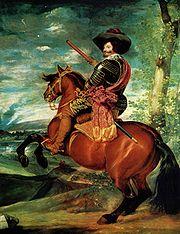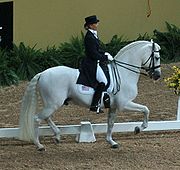
Baroque horse
Encyclopedia


Horses in the Middle Ages
Horses in the Middle Ages differed in size, build and breed from the modern horse, and were, on average, smaller. They were also more central to society than their modern counterparts, being essential for war, agriculture, and transport....
such as the destrier
Destrier
The destrier is the best-known war horse of the medieval era. It carried knights in battles, tournaments, and jousts. It was described by contemporary sources as the Great Horse, due to its size and reputation....
. Specific ancestors of this type include the Neapolitan horse
Neapolitan horse
The Neapolitan Horse, , Neapolitano or Napolitano, is a horse breed that originated in the plains between Naples and Caserta, in the Campania region of Italy, but which may have been bred throughout the Kingdom of Naples. The Neapolitan horse was frequently mentioned in literature from the 16th to...
, and the Iberian horse
Iberian horse
The Iberian horse is a title given to a number of horse breeds native to the Iberian peninsula. At present, 17 horse breeds are recognized by FAO as characteristic of the Iberian Peninsula....
of Barb
Barb (horse)
Developed on the Barbary Coast of North Africa, the Barb horse is a desert breed with great hardiness and stamina. The Barb generally possesses a fiery temperament and an atypical sport-horse conformation, but nevertheless has influenced modern breeds....
ancestry known in the Middle Ages
Middle Ages
The Middle Ages is a periodization of European history from the 5th century to the 15th century. The Middle Ages follows the fall of the Western Roman Empire in 476 and precedes the Early Modern Era. It is the middle period of a three-period division of Western history: Classic, Medieval and Modern...
as the Spanish Jennet
Jennet
A Jennet or Spanish Jennet was a small Spanish horse. It was noted for a smooth naturally ambling gait, compact and well-muscled build, and a good disposition...
. They are characterized by powerful hindquarters, a muscular, arched neck, a straight or slightly convex profile, and usually a full, thick mane
Mane (horse)
The mane is the hair that grows from the top of the neck of a horse or other equine, reaching from the poll to the withers, and includes the forelock or foretop. It is thicker and coarser than the rest of the horse's coat, and naturally grows to roughly cover the neck...
and tail. These horses are particularly well-suited for the haute ecole discipline of classical dressage
Classical dressage
Classical dressage evolved from cavalry movements and training for the battlefield, and has since developed into the competitive dressage seen today...
The modern breeds included in this category include the Andalusian horse
Andalusian horse
The Andalusian, also known as the Pure Spanish Horse or PRE , is a horse breed developed in the Iberian Peninsula. Its ancestors have been present on the Iberian Peninsula for thousands of years. The Andalusian has been recognized as an individual breed since the 15th century, and its conformation...
, Frederiksborger
Frederiksborg horse
The Frederiksborger is Denmark's oldest horse breed. They were tremendously popular throughout the Renaissance and Baroque periods and were considered luxury items. Today the breed is rare, but has a loyal following. Stallions and mares undergo studbook inspections before being allowed to breed...
, Friesian
Friesian horse
The Friesian is a horse breed originating in Friesland, Netherlands. Although the breed's conformation resembles that of a light draft horse, Friesians are graceful and nimble for their size. During the Middle Ages, it is believed that the ancestors of Friesian horses were in great demand as war...
, Ginetta, Kladruber
Kladruber
The Kladruber is the oldest Czech horse breed, and today is considered very rare. The main breeding centre is in National stud farm Kladruby nad Labem in the Czech republic where Kladrubers have been bred for more than 400 years, being now one of the world's oldest horse breeds...
, Knabstrupper (non-sport horse
Sport horse
Sport horse, or Sporthorse, is a term used to describe a type of horse, rather than any particular breed. The term generally refers to horses bred for the traditional Olympic equestrian sporting events of dressage, eventing, show jumping, and combined driving. The precise definition varies...
type), the Lipizzan
Lipizzan
The Lipizzan or Lipizzaner , is a breed of horse closely associated with the Spanish Riding School of Vienna, Austria, where the finest representatives demonstrate the haute école or "high school" movements of classical dressage, including the highly controlled, stylized jumps and other movements...
, Lusitano
Lusitano
The Lusitano is a Portuguese horse breed, closely related to the Spanish Andalusian horse. Both are sometimes called Iberian horses, as the breeds both developed on the Iberian peninsula, and until the 1960s they were considered one breed, under the Andalusian name...
, Menorquina, Murgese
Murgese
The Murgese horse, also known as the Murghese or Murge Horse originated in the Murge, Apulia area of Italy during the Spanish rule, and were developed from Barb and Arabian horses...
, and crossbreds such as the Warlander
Warlander
The Warlander is a horse of Baroque type, produced by crossing Andalusian and Friesian breeds. The ideal Warlander combines the Andalusian's intelligence, facility for collection, flexibility, and powerful hindquarters, with the Friesian's tractability, dramatic leg action, "bone", and strong...
. Lipizzans are probably the best known of the Baroque type breeds due to their national showcase at the Spanish Riding School
Spanish Riding School
The Spanish Riding School of Vienna, Austria, is a traditional riding school for Lipizzan horses, which perform in the Winter Riding School in the Hofburg...
in Vienna
Vienna
Vienna is the capital and largest city of the Republic of Austria and one of the nine states of Austria. Vienna is Austria's primary city, with a population of about 1.723 million , and is by far the largest city in Austria, as well as its cultural, economic, and political centre...
, Austria.
See also
- DestrierDestrierThe destrier is the best-known war horse of the medieval era. It carried knights in battles, tournaments, and jousts. It was described by contemporary sources as the Great Horse, due to its size and reputation....
- Horses in the Middle AgesHorses in the Middle AgesHorses in the Middle Ages differed in size, build and breed from the modern horse, and were, on average, smaller. They were also more central to society than their modern counterparts, being essential for war, agriculture, and transport....
- Horses in WarfareHorses in warfareThe first use of horses in warfare occurred over 5,000 years ago. The earliest evidence of horses ridden in warfare dates from Eurasia between 4000 and 3000 BC. A Sumerian illustration of warfare from 2500 BC depicts some type of equine pulling wagons...
- Classical dressageClassical dressageClassical dressage evolved from cavalry movements and training for the battlefield, and has since developed into the competitive dressage seen today...

